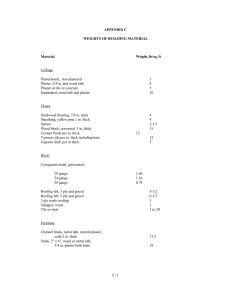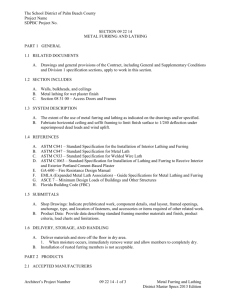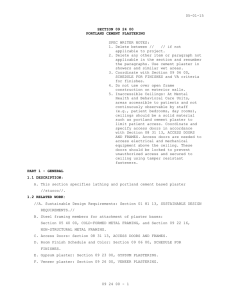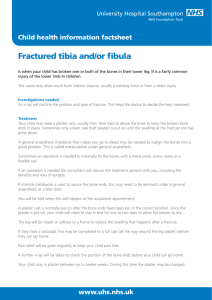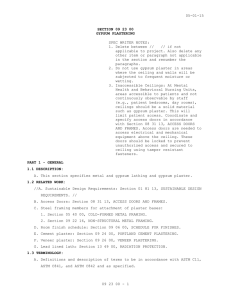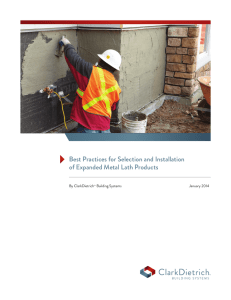************************************************************************** USACE / NAVFAC / AFCEC / NASA ...
advertisement
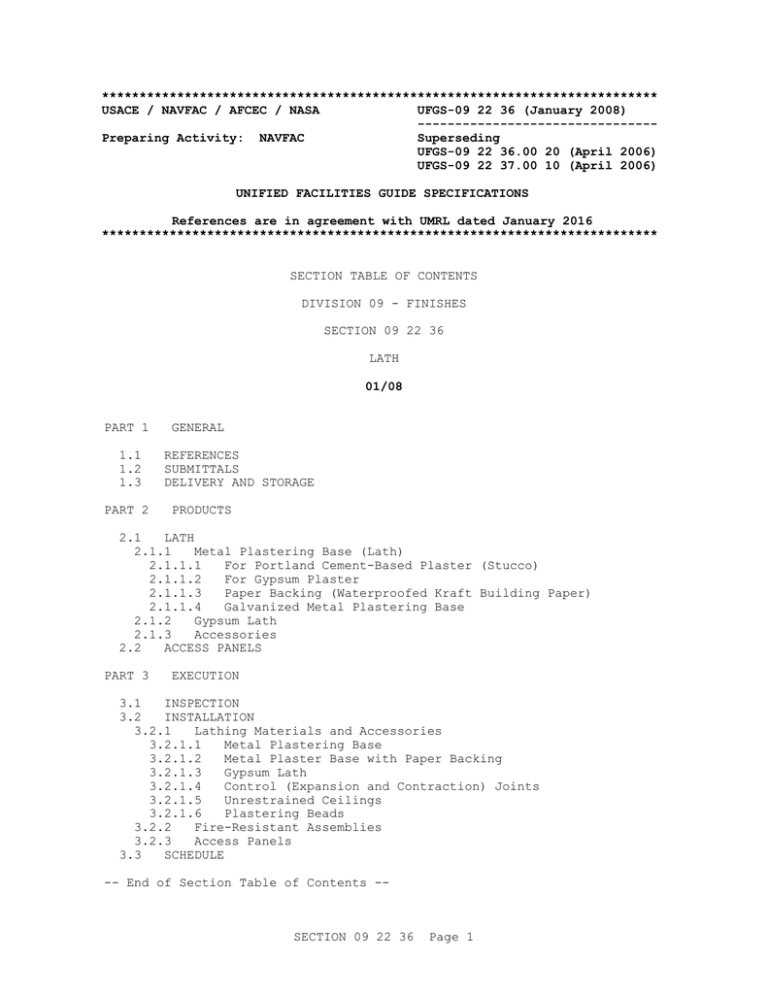
************************************************************************** USACE / NAVFAC / AFCEC / NASA UFGS-09 22 36 (January 2008) -------------------------------Preparing Activity: NAVFAC Superseding UFGS-09 22 36.00 20 (April 2006) UFGS-09 22 37.00 10 (April 2006) UNIFIED FACILITIES GUIDE SPECIFICATIONS References are in agreement with UMRL dated January 2016 ************************************************************************** SECTION TABLE OF CONTENTS DIVISION 09 - FINISHES SECTION 09 22 36 LATH 01/08 PART 1 1.1 1.2 1.3 PART 2 GENERAL REFERENCES SUBMITTALS DELIVERY AND STORAGE PRODUCTS 2.1 LATH 2.1.1 Metal Plastering Base (Lath) 2.1.1.1 For Portland Cement-Based Plaster (Stucco) 2.1.1.2 For Gypsum Plaster 2.1.1.3 Paper Backing (Waterproofed Kraft Building Paper) 2.1.1.4 Galvanized Metal Plastering Base 2.1.2 Gypsum Lath 2.1.3 Accessories 2.2 ACCESS PANELS PART 3 EXECUTION 3.1 INSPECTION 3.2 INSTALLATION 3.2.1 Lathing Materials and Accessories 3.2.1.1 Metal Plastering Base 3.2.1.2 Metal Plaster Base with Paper Backing 3.2.1.3 Gypsum Lath 3.2.1.4 Control (Expansion and Contraction) Joints 3.2.1.5 Unrestrained Ceilings 3.2.1.6 Plastering Beads 3.2.2 Fire-Resistant Assemblies 3.2.3 Access Panels 3.3 SCHEDULE -- End of Section Table of Contents -- SECTION 09 22 36 Page 1 ************************************************************************** USACE / NAVFAC / AFCEC / NASA UFGS-09 22 36 (January 2008) -------------------------------Preparing Activity: NAVFAC Superseding UFGS-09 22 36.00 20 (April 2006) UFGS-09 22 37.00 10 (April 2006) UNIFIED FACILITIES GUIDE SPECIFICATIONS References are in agreement with UMRL dated January 2016 ************************************************************************** SECTION 09 22 36 LATH 01/08 ************************************************************************** NOTE: This guide specification covers the requirements for lathing for gypsum and portland cement-based plaster work. Adhere to UFC 1-300-02 Unified Facilities Guide Specifications (UFGS) Format Standard when editing this guide specification or preparing new project specification sections. Edit this guide specification for project specific requirements by adding, deleting, or revising text. For bracketed items, choose applicable items(s) or insert appropriate information. Remove information and requirements not required in respective project, whether or not brackets are present. Comments, suggestions and recommended changes for this guide specification are welcome and should be submitted as a Criteria Change Request (CCR). ************************************************************************** ************************************************************************** NOTE: Metal framing, furring and ceiling suspension systems for lathing are specified in Section 05 40 00 COLD-FORMED METAL FRAMING and Section 09 22 00 SUPPORTS FOR PLASTER AND GYPSUM BOARD. NOTE: If discoloration of exterior plaster work along the lines of the framing system used to support the lath (metal framing in particular and wood framing to a lesser extent) occurs or is anticipated, design the exterior wall with a thermal break between the metal lath and the framing members. One suggested solution is to install 12.7 mm 1/2 inch thick gypsum sheathing board, conforming to ASTM C79, "Gypsum Sheathing Board," on the framing members before attaching the metal lath. ************************************************************************** SECTION 09 22 36 Page 2 ************************************************************************** NOTE: On the drawings, show: 1. Location and extent of plastering 2. Type(s) and spacing of supports 3. Type(s) of plaster and location 4. Control joint locations 5. Fire resistance rating(s), where applicable 6. Sound transmission class (STC) rating(s), where applicable 7. Location and size of access panels and fabrication details for access panels larger than 600 by 900 mm 24 by 36 inches. ************************************************************************** PART 1 1.1 GENERAL REFERENCES ************************************************************************** NOTE: This paragraph is used to list the publications cited in the text of the guide specification. The publications are referred to in the text by basic designation only and listed in this paragraph by organization, designation, date, and title. Use the Reference Wizard's Check Reference feature when you add a RID outside of the Section's Reference Article to automatically place the reference in the Reference Article. Also use the Reference Wizard's Check Reference feature to update the issue dates. References not used in the text will automatically be deleted from this section of the project specification when you choose to reconcile references in the publish print process. ************************************************************************** The publications listed below form a part of this specification to the extent referenced. The publications are referred to within the text by the basic designation only. ASTM INTERNATIONAL (ASTM) ASTM C1063 (2015) Standard Practice for Installation of Lathing and Furring to Receive Interior and Exterior Portland Cement-Based Plaster ASTM C841 (2003; R 2013) Installation of Interior Lathing and Furring SECTION 09 22 36 Page 3 GYPSUM ASSOCIATION (GA) GA 600 (2009) Fire Resistance Design Manual UNDERWRITERS LABORATORIES (UL) UL Fire Resistance 1.2 (2014) Fire Resistance Directory SUBMITTALS ************************************************************************** NOTE: Review Submittal Description (SD) definitions in Section 01 33 00 SUBMITTAL PROCEDURES and edit the following list to reflect only the submittals required for the project. The Guide Specification technical editors have designated those items that require Government approval, due to their complexity or criticality, with a "G". Generally, other submittal items can be reviewed by the Contractor's Quality Control System. Only add a “G” to an item, if the submittal is sufficiently important or complex in context of the project. For submittals requiring Government approval on Army projects, a code of up to three characters within the submittal tags may be used following the "G" designation to indicate the approving authority. Codes for Army projects using the Resident Management System (RMS) are: "AE" for Architect-Engineer; "DO" for District Office (Engineering Division or other organization in the District Office); "AO" for Area Office; "RO" for Resident Office; and "PO" for Project Office. Codes following the "G" typically are not used for Navy, Air Force, and NASA projects. An "S" following a submittal item indicates that the submittal is required for the Sustainability Notebook to fulfill federally mandated sustainable requirements in accordance with Section 01 33 29 SUSTAINABILITY REPORTING. Choose the first bracketed item for Navy, Air Force and NASA projects, or choose the second bracketed item for Army projects. ************************************************************************** Government approval is required for submittals with a "G" designation; submittals not having a "G" designation are [for Contractor Quality Control approval.][for information only. When used, a designation following the "G" designation identifies the office that will review the submittal for the Government.] Submittals with an "S" are for inclusion in the Sustainability Notebook, in conformance to Section 01 33 29 SUSTAINABILITY REPORTING. Submit the following in accordance with Section 01 33 00 SUBMITTAL PROCEDURES: SD-03 Product Data SECTION 09 22 36 Page 4 Lath Accessories Access panels 1.3 DELIVERY AND STORAGE Deliver materials in the manufacturer's original unbroken packages or containers that are labeled plainly with the manufacturer's names and brands. Store materials in dry locations with adequate ventilation, free from water, and in such a manner to permit easy access for inspection and handling. [Stack gypsum lath flat to avoid sagging or damage to edges, ends, or surfaces, and protect from exposure to direct sunlight.] PART 2 PRODUCTS ************************************************************************** NOTE: This guide specification presents nonproprietary materials. When the guide specification is edited or supplemented to suit project requirements, care shall be exercised to present a project specification section which contains no proprietary materials. ************************************************************************** 2.1 LATH 2.1.1 Metal Plastering Base (Lath) Provide the type(s) and weight(s) required for the type and spacing of supports shown for the kind of plaster indicated and specified. Do not use rib lath for ceramic tile scratch coat. 2.1.1.1 For Portland Cement-Based Plaster (Stucco) ASTM C1063,[ diamond mesh][ self-furring diamond mesh][ flat rib][ 10 mm 3/8 inch rib][ 20 mm 3/4 inch rib][ sheet][ welded wire][ woven wire] metal lath weighing not less than [_____] kilograms per square meter pounds per square yard. 2.1.1.2 For Gypsum Plaster ************************************************************************** NOTE: Consult Table 2 in ASTM C1063 and Table 1 in ASTM C841 to determine the type and weight of the metal lath based on the type and spacing of the support system shown on the project drawings. ************************************************************************** ASTM C841,[ diamond mesh][ self-furring diamond mesh][ flat rib][ 10 mm 3/8 inch rib][ 20 mm 3/4 inch rib][ sheet][ welded wire][ woven wire] metal lath weighing not less than [_____] kilograms per square meter pounds per square yard. 2.1.1.3 Paper Backing (Waterproofed Kraft Building Paper) ************************************************************************** SECTION 09 22 36 Page 5 NOTE: Specify "Moderate water-vapor Resistant" where moisture protection or use of vapor barrier is required. Specify "Water-vapor permeable" to maintain hollow partitions plaster free, to prevent plaster from bonding to substrate, to prevent over spray where plaster is sprayed on, to provide uniform plaster thickness and to improve bonding (keying). Edit paragraph as required. ************************************************************************** Provide metal plastering base with paper backing,[ "Moderate water-vapor Resistant" for room(s) [_____]][ "Water-vapor permeable" for room(s) [_____]][ and][ for exterior plastering work]. 2.1.1.4 Galvanized Metal Plastering Base ************************************************************************** NOTE: Specify galvanized metal plastering base for all exterior plastering and for plastering interior areas subject to high moisture conditions such as natatoriums and shower and laundry rooms. ************************************************************************** Provide[ for exterior plastering work][ and][ for plastering room(s) [_____]][ in all locations]. 2.1.2 Gypsum Lath ************************************************************************** NOTE: Specify only for interior gypsum plastering work in relatively large, flat areas. Do not use for curved areas or areas subject to high moisture conditions. ************************************************************************** ASTM C1063. Provide[ plain][ Type X (fire resistant)][ foil-backed] gypsum lath [9.53] [12.70] mm [3/8] [1/2] inch thick. 2.1.3 Accessories ************************************************************************** NOTE: Referenced ASTM standards permit accessories fabricated from: 1. ASTM C1063: - zinc coated (galvanized) steel - zinc alloy - rigid poly (vinyl chloride) (PVC) plastic 2. - ASTM C841: zinc coated (galvanized) steel paint coated steel rigid poly (vinyl chloride) (PVC) plastic clear plastic coated aluminum If no exceptions are specified, these materials become Contractor options. Include the last SECTION 09 22 36 Page 6 sentence, appropriately edited, to exclude any undesirable options. ************************************************************************** [ASTM C1063. ][ASTM C841. ] [ Provide only[ galvanized steel][ zinc alloy][ rigid poly (vinyl chloride) (PVC) plastic][ clear plastic coated aluminum] accessories.] 2.2 ACCESS PANELS ************************************************************************** NOTE: Detail fabrication of access panels larger than 600 by 900 mm 24 by 36 inches on project drawings. ************************************************************************** Prefabricated steel units, size(s)[ as indicated][ [_____] by [_____] mm inches]. Fabricate frame of preformed angle or channel with welded joints. Perforate wide leg or flange of frame section or extend frame section into expanded metal wings to provide a key for the plaster. Cover shall be hinged or snap-on type with turn-latch or spring catch.[ Provide access panels[ for room(s) [_____]] with a means for locking.] Fabricate access panels not larger than 600 by 900 mm 24 by 36 inches from 1.8 mm thick 14 gage steel with frames not lighter than 1.5 mm thick 16 gage. Fabricate access panels larger than 600 by 900 mm 24 by 36 inches as indicated. Factory-prime panels with rust-inhibitive paint. PART 3 3.1 EXECUTION INSPECTION Verify that framing, furring and accessories are securely attached and of proper sizes and spacing necessary to provide a suitable substrate to receive lath. Do not proceed with work until framing, furring and accessories are acceptable to the Contracting Officer for application of lath. 3.2 INSTALLATION 3.2.1 Lathing Materials and Accessories Install in accordance with[ ASTM C1063 for portland cement-based plaster work][ and][ ASTM C841 for gypsum plaster work], except where indicated or specified otherwise herein. 3.2.1.1 Metal Plastering Base Install[ where indicated][ on wood or metal studding, furring, joists, rafters, and similar framing members for plastered walls, partitions, ceilings, and soffits][ to receive scratch coat for ceramic tile or terrazzo work][ on[ concrete][ and][ masonry] surfaces to receive plaster]. 3.2.1.2 Metal Plaster Base with Paper Backing Where used, lap joints to provide backing on backing and metal-on-metal. Lap backing not less than 25 mm one inch. Lap backing so that water will flow to the exterior. SECTION 09 22 36 Page 7 3.2.1.3 Gypsum Lath Install[ where indicated][ on wood or metal studding, furring, joists, rafters and similar framing members for plastered walls, partitions, ceilings, and soffits]. 3.2.1.4 Control (Expansion and Contraction) Joints a. For portland cement-based plaster (ceilings and walls), install to create panels no larger than 10 square meters l00 square feet with no dimension exceeding 3150 mm 10 feet. b. For unrestrained gypsum plaster ceilings install to create panels no larger than 250 square meters 2,500 square feet with no dimension exceeding 15800 mm 50 feet. For gypsum plaster walls, partitions and ceilings without perimeter relief install not more than 9000 mm 30 feet on centers in either direction. c. Install[ where indicated,] where expansion joints occur in the structural walls and ceilings and where ceiling framing or furring changes direction. Terminate lath at each side of joint and fasten joints securely to lath. 3.2.1.5 Unrestrained Ceilings Furred or suspended ceilings constructed with[ gypsum plaster and larger than 250 square meters 2,500 square feet in area or with any dimension exceeding 15,800 mm 50 feet][ or][ portland cement-based plaster] must be unrestrained. Isolate ceiling lath and plaster from ceiling intersecting vertical surfaces with casing beads, control joints, or similar devices designed to keep the ceiling isolated from the adjacent vertical surfaces (walls, partitions, beams, and columns). Do not use corner reinforcement at the internal angle between the ceiling and the vertical surfaces. 3.2.1.6 Plastering Beads Install edge trim (casing bead)[ at the edges of plaster which abuts or adjoins an unplastered surface,][ on each surface at the internal angle formed by load bearing and non-load bearing walls and partitions abutting structural walls, columns, or floor-ceiling slabs,][ between concrete or terrazzo bases and the plaster above them,][ on each side of the joint between walls or partitions constructed of dissimilar materials which require plastering,][ and between plasters of a different composition]. Fill voids formed in corners with sealant. Install corner beads at all vertical external corners of plaster walls. 3.2.2 Fire-Resistant Assemblies ************************************************************************** NOTE: Coordinate with the preparer of the project drawings to ensure that UL Design Number(s) or GA File Number(s) are indicated on the drawings for fire resistant construction. ************************************************************************** Wherever fire-resistant construction is indicated, provide all materials and application methods, including types and spacing of fasteners, in accordance with the specifications contained in the[ UL Fire Resistance for the Design Number(s) indicated][ or][ GA 600 for the File Number(s) SECTION 09 22 36 Page 8 indicated]. 3.2.3 Access Panels ************************************************************************** NOTE: Project drawings or specifications shall assure that the exact number and location of access panels can be easily determined. Show this information on the drawings. Coordinate with mechanical and electrical work to ensure adequate access to mechanical and electrical systems. Do not install access panels in fire rated walls or ceilings unless approved by the Engineering Field Division's Fire Protection Engineer. ************************************************************************** ************************************************************************** NOTE: Insert appropriate Section number and title in blank below using format per UFC 1-300-02, "Unified Facilities Guide Specifications (UFGS) Format Standard". ************************************************************************** Install in suspended ceilings and plastered walls at locations[ indicated][ and][ specified in [_____]]. 3.3 SCHEDULE Some metric measurements in this section are based on mathematical conversion of inch-pound measurements, and not on metric measurement commonly agreed to by the manufacturers or other parties. The inch-pound and metric measurements are as follows: PRODUCTS INCH-POUND METRIC Access Panels 24 by 36 inches 600 by 900 mm 14 gage 1.8 mm 16 gage 1.5 mm -- End of Section -- SECTION 09 22 36 Page 9
